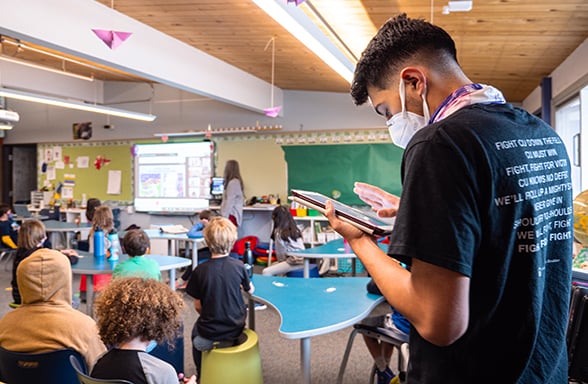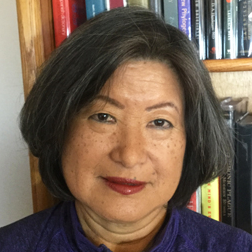The classrooms of Barnum Elementary School in Denver echo with the chatter of students and the instruction of teachers. The white, waist-high, curved machine in the corner is quiet as can be.
The machine, which looks like a less-complicated R2D2, contains a NASA-designed HEPA filter and is part of a cross-campus initiative between the University of Colorado Boulder and the Colorado School of Public Health (ColoradoSPH) at the CU Anschutz Medical Campus. The project’s goal is to test and clean the air in classrooms across the state, preventing the spread of SARS-CoV-2 and keeping the state’s schools open.
Reading the air
Mark Hernandez, PE, PhD, S. J. Archuleta professor of environmental engineering at CU Boulder, is leading the air-filtration part of the initiative that monitors the biomatter in classroom air. The system, designed at CU Boulder, is borrowed from a military technology that was used for bioterrorism or biological warfare assessment.
“This crossed over in the civilian sector for indoor assessment,” Hernandez said. “And prior to COVID-19, it was used for flood-damaged buildings. So we go into the public schools, characterize the ventilation performance and look at that biological quality of what the kids are breathing in school.”
The monitoring system can separate inorganic matter from biological matter in the air, helping assess the levels of viruses, such as RSV, influenza, COVID-19, tuberculosis, whooping cough and COVID-19. Hernandez’s lab has been researching the characterization and control of airborne microorganisms for almost 25 years. The study uses the large bioaerosol chamber in Hernandez's lab.
 “We are using classic methods for culturing mammalian viruses as well as emerging instrumentation from the Colorado tech sector that helps them characterize the identity, distribution and infectious potential of indoor airborne microorganisms — notably including coronavirus,” Hernandez said.
“We are using classic methods for culturing mammalian viruses as well as emerging instrumentation from the Colorado tech sector that helps them characterize the identity, distribution and infectious potential of indoor airborne microorganisms — notably including coronavirus,” Hernandez said.
Testing student masks
After seeing Hernandez’s project featured on 9News, May Chu, PhD, a clinical professor in epidemiology at the ColoradoSPH, reached out. Chu and her team have spent the last year successfully implementing a COVID-19 testing program in Denver Public Schools and local universities. The project uses disposable face coverings (masks) with a polyvinyl alcohol strip inside, right under the wearer’s nose, used to detect SARS-CoV-2.
Students who opt to participate in the study – which is currently testing at seven college campuses representing 73% of all the registered college students in the state and at four K-12 schools – pick up masks in the morning and return them three to four hours later. Once the student hands in their mask, the ColoradoSPH team works with COVID Check Colorado to administer a nasal swab PCR test to detect SARS-CoV-2. The school gets the results of the nasal swab testing in the evening each day.
The study, funded by the World Health Organization, also includes the University of Leicester in England. Using the strip, researchers can determine whether participants are COVID-19-positive, even those who are asymptomatic or test negative through a nasal swab PCR test.
While the ColoradoSPH team has received overwhelming support from schools that welcomed the help to test students, they have been slow to find new participants, as many are experiencing burnout with all COVID-related activities and discussions.
“Our theory is that someone could be infected with SARS-CoV-2 in their nose, but we want to understand how much they’re actually exhaling the virus, because it's the exhalation that makes the person infectious,” Chu said. “If it stays in your nasal cavity and is not detected by the strips in a mask, then there's a good chance you're really not at high risk of infecting other people. We believe there is a difference in being PCR-positive and being actually of some risk.”
Keeping levels at bay
While the machines testing and filtering the air from Hernandez’s project give easy-to-read levels that schools can monitor independently, the ColoradoSPH team is working to compare the levels of SARS-CoV-2 in the air with the mask and positivity rates from her study. The ColoradoSPH study is seeking evidence that may lead to delineating when people should or should not wear a mask.
“If it stays in your nasal cavity and is not detected by the strips in a mask, then there's a good chance you're really not at high risk of infecting other people. We believe there is a difference in being PCR-positive and being actually of some risk.” – May Chu, PhD
“These students are in congregate situations all day, in dorms, at parties, shouting at sporting events, etcetera. So we hope to determine the ways in which they’re transmitting the virus or not,” Chu said.
“We want to find out the metrics that we can use to measure a classroom by the level of infectivity in the students and teachers,” Chu said. “This will allow schools to stay open because they’ll be able to measure and test the viral content in the air, and hopefully meet the metrics of low transmission, low particles or have high particles with fast removal.”
“This partnership between the ColoradoSPH and CU Boulder is so important,” Hernandez said. “We are interfacing building science and engineering with epidemiology, which we have never done before.”




